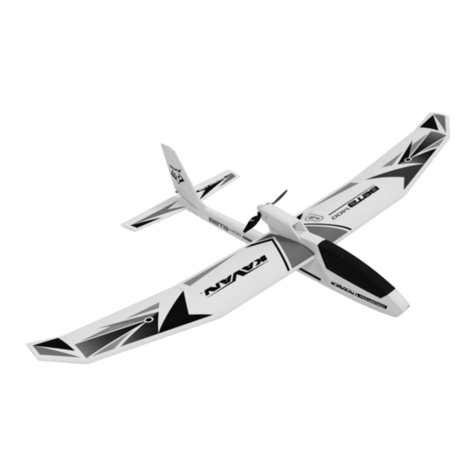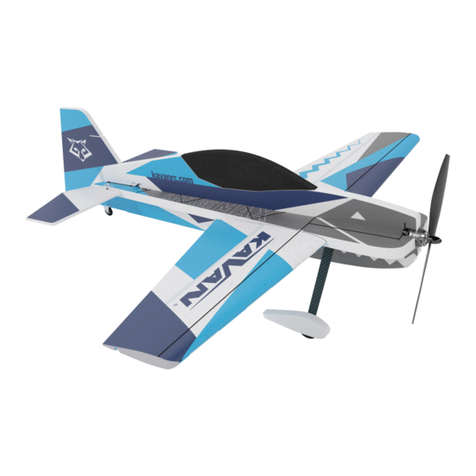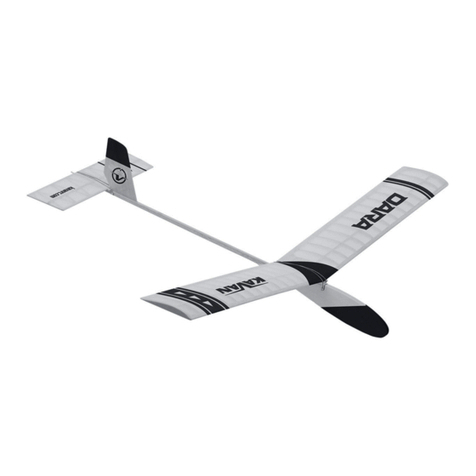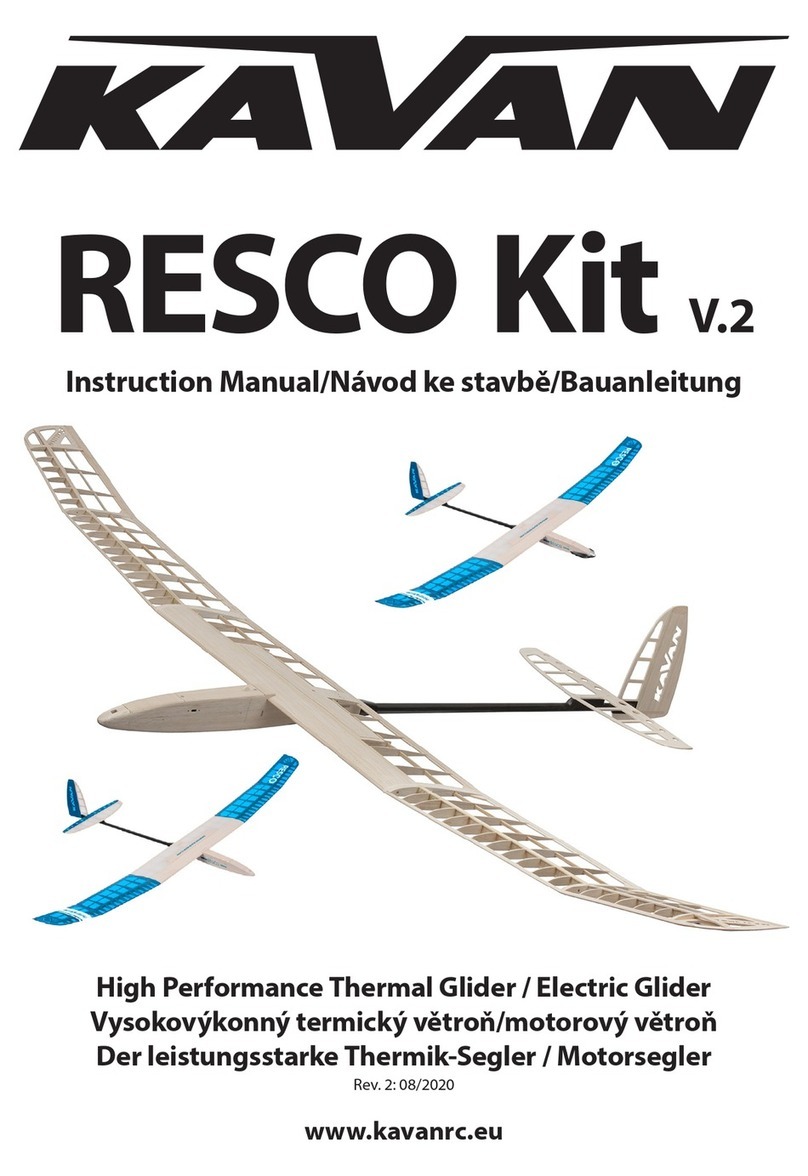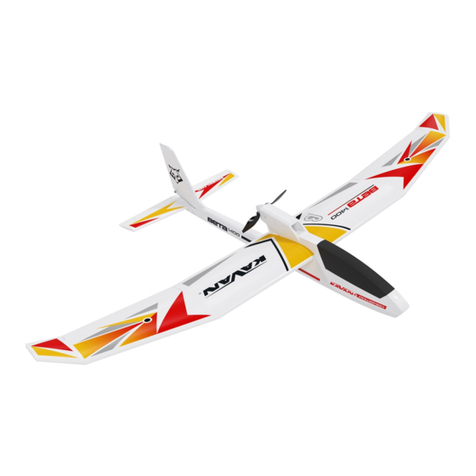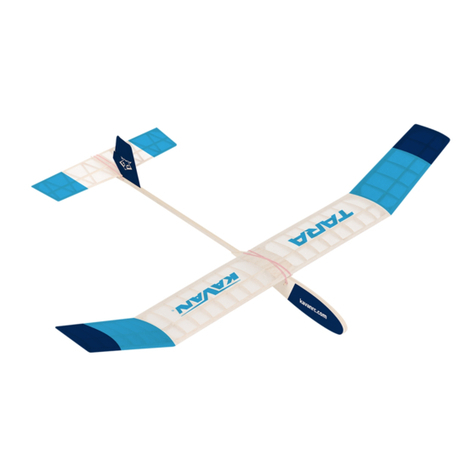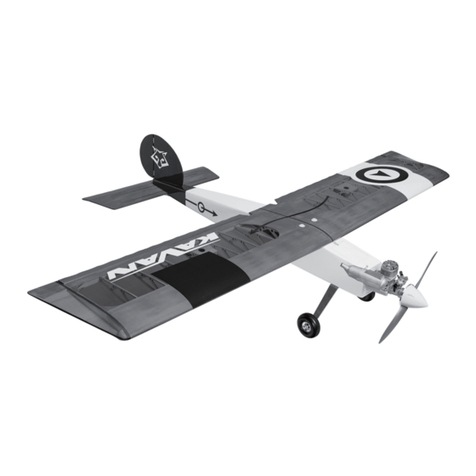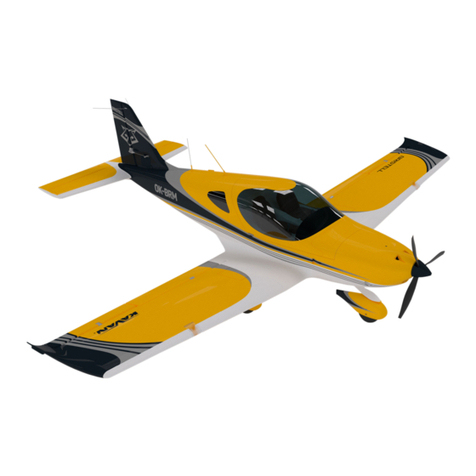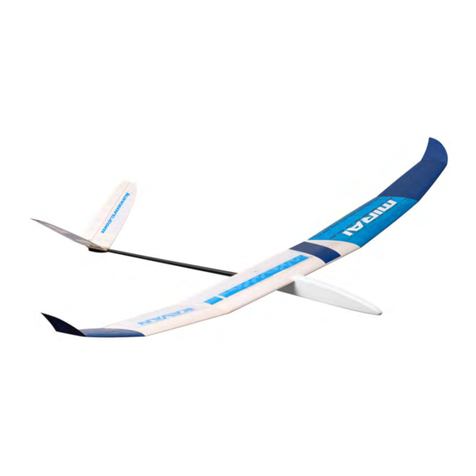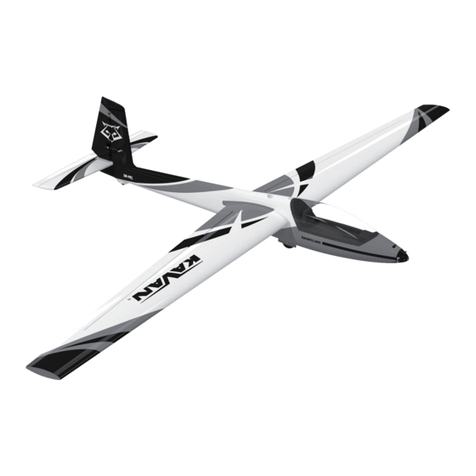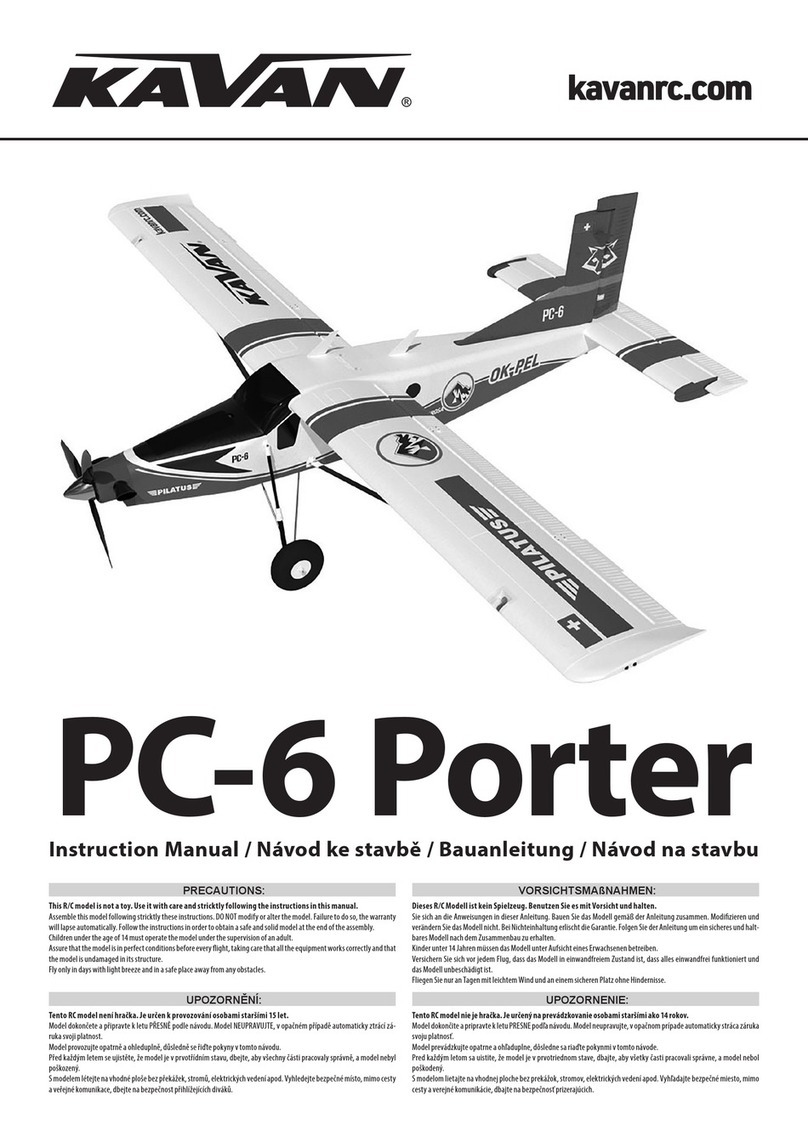
7
Der Kleine FALKE
EINLEITUNG
Der Segler Der Kleine FALKE ist bestimmt für Modellbauneulinge. Er ist
ideal, um sich mit dem klassischen Aufbau vertraut zu machen. Sie kö-
nnen ihn als ein frei iegendes Modell bauen (es entspricht den Regeln
der Klasse F1H oder A1). Sie können ihn auch mit einem Miniatur-RC-Set
und bzw. mit einer Antriebseinheit mit Elektromotor ausstatten und als
ein ferngesteuertes Modell betreiben. Sie brauchen die grundlegenden
Modellbauwerkzeuge, Klebstoe und Lackarten, die Sie in Zukunft auch
beim Bau von anderen Modellen verwenden. Vor dem Baubeginn studie-
ren Sie, bitte, gründlich die Bauanleitung und die Bauskizze.
TECHNISCHE ANGABEN
Spannweite 1240 mm
Länge 870 mm
Gewicht ca. 160 g (F1H: min. 220 g)
BEVOR SIE BEGINNEN
Klebstoe: Sie können Aceton-Klebstoe (UHU® Hart u.ä.), wasserdich-
te Dispersions-Klebstoe (KAV9960 KAVAN Weißleim u.ä.) oder einen
mittelüssigen Sekundenkleber (KAV9952 KAVAN CA mittelüssig u.ä.)
verwenden.
Lackarten: Zaponlack (KAV9988) und Verdünner für ihn (KAV9990) aus
der KAVAN Classic Reihe.
Werkzeuge und andere Notwendigkeiten: Perfekt ache Arbeit-
splatte (z.B. Stabsperrholz oder Leimholzplatte mindestens 150x700
mm), in die Stecknadeln eingesetzt werden können (KAV0355 Modell-
bau-Stecknadeln), rechtwinkliges Dreieck oder Winkellineal, Schleif-
schwamm oder Schleifpapiere Nr. 180-200 und 360-400, Stecknadeln,
weicher Haar-Flachpinsel, dünne klare Kunststofolie zum Abdecken des
Bauplans/Arbeitsplatte (z.B. ein aufgeschnittener großer Polyethylenbe-
utel, Abdeckfolien für Raummaler u.ä.).
BAU DES MODELLS
Bevor Sie mit dem Bau beginnen, sollten Sie sich entscheiden, in welcher
Ausführung Sie das Modell fertigstellen:
Frei iegender Segler: Der Kleine FALKE entspricht den Regeln der Wett-
bewerbskategorie F1H (A1), wenn Sie ihn so auswiegen, dass das Flug-
gewicht min. 220 g beträgt.
RC Segler: Mit einem Miniaturempfänger und zwei 5-6g Mikroservos gewi-
nnen Sie einen perfekten kleinen Segler mit einem steuerbaren Seiten- und
Höhenruder, der ruhig auch Ihr erstes RC-Modell sein kann. Das Fluggewicht
sollte ebenfalls gegen 220 g betragen.
RC Motorsegler: Die Konstruktion des Modells ermöglicht auch den Einsatz
einer Antriebseinheit mit einem kleinen Brushless-Motor mit Druckpropeller
am Pylon über dem Flügel. In dieser Ausführung sollte das Fluggewicht etwa
300-320 g betragen.
Flügel
1) Beide Hälften der Nasenleiste des Flügels Nr.1 und Nr.2 schleifen Sie
mit einem Schleifschwamm. Schleifen Sie die Nasenleiste in die richtige
Form – siehe den Schnitt durch den Flügel links oben auf dem Bauplan.
2) Auf einer achen Unterlage, die mit einer dünnen Kunststofolie über-
deckt ist, kleben Sie an das Nasenteil des Flügels Nr.1 die Leiste Nr.3.
Achten Sie auf ihre richtige Orientierung – siehe den Schnitt durch den
Flügel links oben auf dem Bauplan. Vor dem Kleben legen Sie beide Teile
trockenzueinanderundschleifenSie,wennesnötigist,damitsie perfekt
zusammenpassen.
3) Nach dem Aushärten des Klebstos schleifen Sie die untere Seite der
verklebten Teile Nr.1 und Nr.3 in eine Ebene.
4)DasNasenteilder Flügelhälfte unterlegen Sie miteiner geeigneten Leiste
und kleben Sie daran die Endleiste des Flügels Nr.4.
5) Nach dem Aushärten des Klebstos schleifen Sie die Flügelhälfte so, da-
mit die Nasen- und Endleiste genau bündig sind.
6) An das äußere Ende der Flügelhälfte kleben Sie die Leiste Nr.8. Nach
dem Trocknen schleifen Sie sie nach dem Flügelprol. Auf gleiche Weise
bauen Sie auch die zweite Flügelhälfte.
7) Aus den Teilen Nr.5 und Nr.6 kleben Sie den Flügelverbinder.
8)
LegenSiedenVerbinderversuchsweiseindieAusschnittederFlügelhälften
ein. Setzen Sie die Flügelhälften zusammen, die an den Enden so unterlegt
sind, damit die richtige Schränkung von 35 mm entsteht (siehe das Bild
links auf dem Bauplan). Schleifen Siedie Kontaktächen der Flügelhälften
in einem Winkel so, damit die beiden Flügelhälften perfekt passen.
9)WennSie zufriedensind,klebenSieineineFlügelhälftedenFlügelverbin-
der. Nach seinem Trocknen kleben Sie die zweite Flügelhälfte so, damit
die richtige Schränkung eingehalten wird.
10) Kleben Sie die Flügelohren aus zwei Teilen Nr.9. Schleifen Sie den Ver-
bindermiteinem Schleifschwammglatt.Dannkleben SiedieOhrenzum
Flügel-Mittelteil so, damit die richtige Schränkung eingehalten wird
(siehe das Bild links auf dem Bauplan).
11) Kleben Sie die Flügelverstärkung Nr.7.
12) Lackieren Sie den ganzen Flügel mit einem dünnen Zaponlack. Tragen
Sieschrittweise3Lackschichtenauf,jedeSchichtschleifenSienachdem
Trocknen leicht mit einem feinen Schleifschwamm. Am Ende bekleben
Sie den Flügel mit Aufklebern.
Rumpf und Leitwerke
1) Kleben Sie die Rumpftrennwände Nr.18-22 an das Grundteil des Rum-
pfes Nr.10 senkrecht.
2) Kleben Sie die oberen Seitenleisten Nr.34 an die Trennwänden.
3) Schrittweise kleben Sie die Teile des Rumpfbuges Nr.11-13.
4) Schrittweise kleben Sie die Teile des Rumpfendes Nr.28-33.
5) Kleben Sie die unteren Seitenleisten des Rumpfes Nr.41.
6) Beide Rumpfseiten schleifen Sie glatt nach dem Bauplan.
7) Kleben Sie die Seitenwände des Rumpfes Nr.23.
8) Kleben Sie das Rumpfteil Nr.14. Tragen Sie den Klebsto NUR im Vor-
derteil auf, wo er sich mit dem Teil Nr. 13 trit, und nur punktuell im
Hinterteil (am Flügelzurrstift).
9) Kleben Sie die weiteren Teile des oberen Rumpfteiles Nr. 15-17.
10) Schleifen Sie den Rumpf in runde Formen und schleifen Sie ihn leicht.
11) Bohren Sie die Löcher für die Zurrstifte des Flügels mit einem 2,5 mm
Bohrer. Kleben Sie die Stifte ein.
12) An der angedeuteten Stelle des Teils Nr.14 schneiden Sie es mit einem
Rasiermesser und trennen Sie vorsichtig die Kabinenabdeckung vom
Rumpf. An das untere Teil vorne kleben Sie das Teil Nr. 27. Achtung, das
Teil überlappt die vordere Kante der Kabinenabdeckung – die Überla-
ppung ist am Teil Nr. 27 durch eine Linie gekennzeichnet.
13) Befestigen Sie den Flügel am Rumpf mit Gummiringen. Im hinteren Teil
der Kabinenabdeckung schleifen Sie allmählich den Übergang so, damit
er gut auf den Flügel passt.
14) Kleben Sie die innere Stützplatte des Hochstarthakens Nr. 24 auf den
Rumpfboden so, damit das angedeutete Loch für den Hochstarthaken in
der Längsachse des Rumpfes ist. Bohren Sie das Loch mit einem 1,5 mm
Bohrer. Bei seiner Önung auf der unteren Seite des Rumpfes kleben Sie
die äußere Stützplatte Nr.25.
